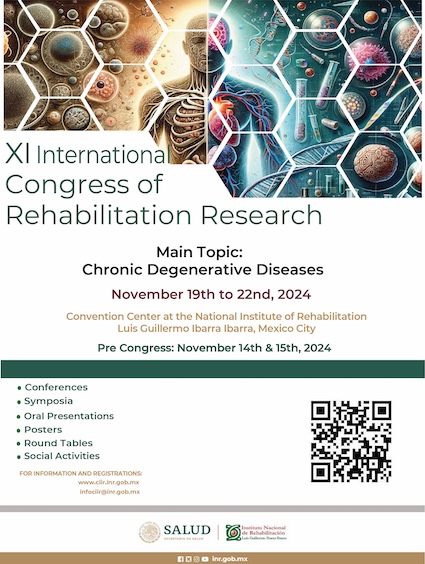Development of the Spanish version of the Barry-Albright Dystonia Scale: translation, cross-cultural adaptation and determination of reliability and validity of content in Mexican patients with dyskinetic cerebral palsy. Pilot study
DOI:
https://doi.org/10.35366/113826Keywords:
dyskinetic cerebral palsy,, dystonia, Barry-Albright Dystonia scale, translation, Mexican patientsAbstract
Introduction: dystonia is an abnormal pattern of posture and/or involuntary, uncontrolled, recurrent, occasionally stereotyped movement. Barry-Albright Dystonia Scale (BADS) is one of the most useful clinical tools to measure dystonia in children with cerebral palsy. There is no Spanish version of a scale that measures dystonia. Objective: to develop the Spanish Barry-Albright Dystonia Scale (BADS) and evaluate the inter and intrarater reliability of the scale and to measure its validity in the Mexican population with dyskinetic cerebral palsy. Material and methods: we developed the Spanish version of the BADS for children with dyskinetic cerebral palsy in the Mexican population by the forward and backward translation procedure and testing for acceptability and the clarity of item wording so that the scale could be used by Spanish-speaking examiners. The studies included the validity of content (using Delphi method by a panel of experts), inter and intrarater reliability which were examined by 2 raters in 30 videos of patients with dyskinetic cerebral palsy twice on two occasions using the spanish BADS. Results: the intrarater and interrater reliability was very good for the Spanish BADS (Pearson correlation coefficient > 0.90) with a statistically significant agreement between raters and within raters (all p < 0.001), the scale also translated into Spanish, obtained a high content validity index (I-CI 0.82-0.94). Conclusions: the spanish version of the Barry-Albright Dystonia Scale showed high content value, as well as adequate inter and intrarater reliability. The scale constitutes an understandable, viable, simple and useful instrument.
References
Rosenbaum P, Paneth N, Leviton A, Goldstein M, Bax M. A report: the definition and classification of cerebral palsy. Dev Med Child Neurol Suppl. 2007; 109: 8-14.
Oskoui M, Coutinho F, Dykeman J, Jetté N, Pringsheim T. An update on the prevalence of cerebral palsy: a systematic review and meta-analysis. Dev Med Child Neurol. 2013; 55 (6): 509-519.
Khandaker G, Smithers-Sheedy H, Islam J, Alam M, Jung J, Novak I et al. Bangladesh cerebral palsy register (BCPR): a pilot study to develop a national cerebral palsy (CP) register with surveillance of children for CP. BMC Neurol. 2015; 15:173.
National health program 2001-2006. PreveR-Dis. CNR/SS. ISBN 968-811-992-X. 2001. Spanish.
Hubermann L, Boychuck Z, Shevell M, Majnemer A. Age at referral of children for initial diagnosis of cerebral palsy
and rehabilitation: current practices. J Child Neurol. 2016; 31 (3): 364-369.
Novak I, Morgan C, Adde L, Blackman J, Boyd R, Brunstrom-Hernández J et al. Early, accurate diagnosis and early intervention in cerebral palsy: advances in diagnosis and treatment. JAMA Pediatr. 2017; 171 (9): 897-890.
Te Velde A, Morgan C, Novak I, Tantsis E, Badawi N. Early diagnosis and classification of cerebral palsy: an
historical perspective and barriers to an early diagnosis. J Clin Med. 2019; 8:1599.
SCPE guide for the registration of cerebral palsy. Instructions and reference documents. 2016. Available in: https://eu-rd-platform.jrc.ec.europa.eu/sites/default/files/SCPE_guide_for_registration_of_cerebral_palsy_V3.pdf
Monbaliu E, Himmelmann K, Lin JP , Ortibus E, Bonouvrié L, Feys H et al. Clinical presentation and management
of dyskinetic cerebral palsy. Lancet Neurol. 2017; 16 (9): 741-749.
Himmelmann K, Hagberg G, Wiklund L, Eek M, Uvebrant P. Dyskinetic cerebral palsy: a population based study of
children born between 1991 and 1998. Dev Med Child Neurol. 2007; 49: 246-251.
Barry M, VanSwearingen J, Albright A. Reliability and responsiveness of the Barry-Albright Dystonia Scale.
Dev Med Child Neurol. 1999; 41 (6): 404-411.
Himmelmann K, Panteliadis C. Clinical Characteristics. In: Panteliadis C, ed. Cerebral Palsy, a multidisciplinary
approach. 3rd ed. Thessaloniki, Greece. 2018, 75-88.
Report of the Australian Cerebral Palsy Register, Birth Years 1995-2012, November 2018. [Accessed 2020] Available in: https://cpregister.com/wp-content/uploads/2019/02/Report-of-the Australian-Cerebral-Palsy-Register-Birth-Years-1995-2012.pdf
Cans C, Dolk H, Platt M, Colver A, Prasauskene A, Krageloh-Mann I. Recommendations from the SCPE collaborative group for defining and classifying cerebral palsy. Dev Med Child Neurol. 2007; 49: 35-38.
Stewart K, Harvey A, Johnston L. A systematic review of scales to measure dystonia and choreoathetosis in children with dyskinetic cerebral palsy. Dev Med Child Neurol. 2017; 59 (8): 786-795.
Monbaliu E, De Cock P, Ortibus E, Heyrman L, Klingels K, Feys H. Clinical patterns of dystonia and choreoathetosis in participants with dyskinetic cerebral palsy. Dev Med Child Neurol. 2016; 58: 138-144.
Kim K, Ahn P, Ryu M, Shin D, Yi S, Yoon D, Ha Y. Long-term surgical outcomes of cervical myelopathy with athetoid
cerebral palsy. Eur Spine J. 2014; 23 (7): 1464-1471.
Quartarone A, Hallett M. Emerging concepts in the physiological basis of dystonia. Mov Disord. 2013; 28 (7): 958-967.
Delgado M, Albright A. Movement disorders in children: definitions, classifications, and grading systems. J Child
Neurol. 2003; 18 (1 Suppl), S1-S8.
Ramada-Rodilla J, Serra-Pujadas C, Delclós-Clanchet G. Cross-cultural adaptation and health questionnaires validation: revision and methodological recommendations. Salud Pública Mex. 2013; 55: 57-66.
Beaton D, Bombardier C, Guillemin F, Ferraz M. Guidelines for the process of cross-cultural adaptation of
self-report measures. Spine. 2000; 25 (24): 3186-3191.
Haberfehlner H, Goudriaan M, Bonouvrié LA et al. Instrumented assessment of motor function in dyskinetic cerebral palsy: a systematic review. J Neuroeng Rehabil. 2020; 17 (1): 39.
Guillemin F, Bombardier C, Beaton D. Cross-cultural adaptation of health-related quality of life measures: Literature review and proposed guidelines. J Clin Epidemiol. 1993; 46 (12): 1417-1432.
Downloads
Published
How to Cite
Issue
Section
License
Copyright (c) 2024 Instituto Nacional de Rehabilitación Luis Guillermo Ibarra Ibarra

This work is licensed under a Creative Commons Attribution 4.0 International License.
© Instituto Nacional de Rehabilitación Luis Guillermo Ibarra Ibarra under a Creative Commons Attribution 4.0 International (CC BY 4.0) license which allows to reproduce and modify the content if appropiate recognition to the original source is given.




